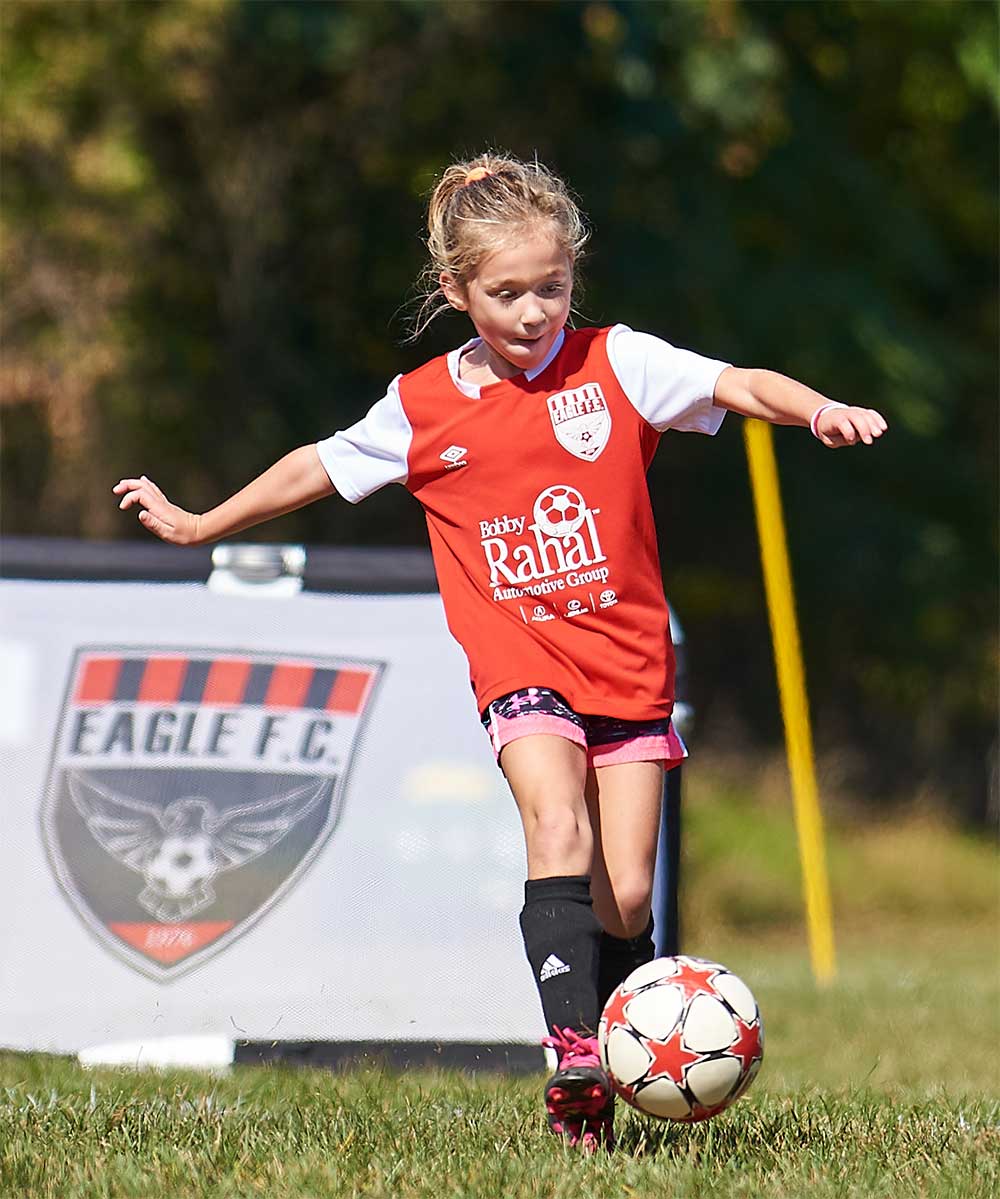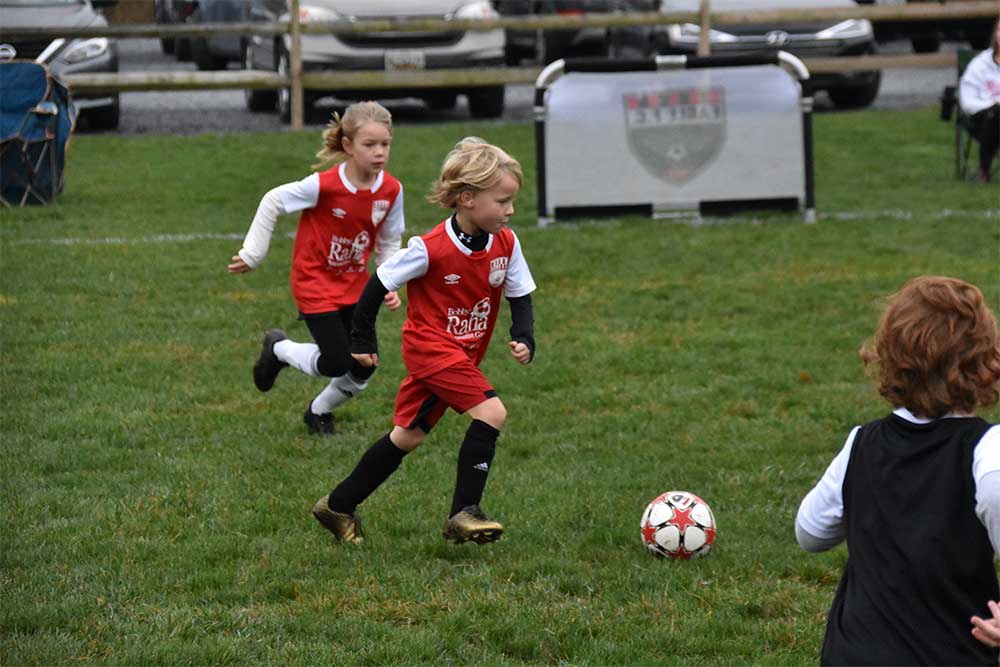Each player will be given a red and a black shirt. Players should wear either the red or black shirt to each practice and bring both shirts on game day. Additionally, players should dress for the weather and wear / bring the following:
– Shin Guards
– Soccer socks to go over shin guards
– Soccer shoes or any athletic shoes
– Inflated soccer ball (U6 and U7 – Size #3 / U8 and U9 – Size #4)
– Water
There is a Fall and Spring season for the Futures program. The Fall season runs from late August until the end of October and the Spring season runs from early April until late May.
Registration for the Fall typically opens in June and closes in early August. Registration for the Spring typically opens in January and closes in early March. The link to registration can be found on the Eagle FC website and our social media.
Many of our age groups do fill up, so don’t wait until the last minute! Also, keep in mind, late registrations do incur extra fees and withdrawals also incur a processing fee. Those details will be noted in the registration form.
If you do have a special request for your player, please communicate that information to the Futures Director at the time of registering. Once groups / teams are announced it may not be possible to accommodate special requests.
Hidden Creek is a centralized location for Hampden, Middlesex. Monroe, Silver Spring and the greater Mechanicsburg area including Camp Hill, Carlisle, and East Pennsboro. We wanted the entire U6 to U9 program in one location so we could provide an outstanding training and game environment for our players and their families. It truly feels like a community during the weekdays and on Saturdays. Hidden Creek provides enough space for our FUNino fields, 5v5 fields, and 7v7 fields. Additionally, there is sufficient parking and spaces to store goals and gear. The park also has a playground for the kids, portable toilets, a trail along the creek, and a pavilion. We are grateful for the partnership and collaboration from Silver Spring Township Parks and Recreation.
Yes!
We need willing volunteers for each age group. Our program is only successful because of outstanding and dedicated volunteers. The Futures staff coaches will organize training activities and run practices, but we depend on volunteers to assist with training and to help oversee games on Saturday.
Volunteer Responsibilities:
-Willingness to learn, have fun and put kids first
-Assist Futures staff coaches with training
-Equipment set up and clean up
-Run a field on Saturday game day
-Submit PSP clearances
-At U9, volunteers will be assigned to a team that they will manage on game days. The U9 staff coaches will organize and run practices.
The Futures Director, Assistant Director and Club Staff will communicate program details via email, our Byga software, the club website, and also social media. This will allow for efficient and consistent centralized communication and information sharing.
In an effort to create a thoughtful player-centric development progression from 3v3 to 7v7, it is important to have a plan from U6 to U9. Our progression is based on various models from around the world. Decision making, physical capabilities and complexity increase exponentially as you add players to the field, increase the field size and alter the size of the goals. Many programs start off with 4v4 and two goals. It does not always go well and we wanted to do better.
-U6 and U7 Coed – FUNino 3v3 with four 3’x5′ goals (20yd x 30yd field)
-U8 Boys/Girls – 4v4 plus GK with two 6’x10′ goals (30yd x 40yd field)
-U9 Boys/Girls –7v7 with two 6’x18′ goals (40yd x 65yd field)
For our younger players, there are some challenges in creating fair teams, maintaining even numbers, and ensuring attendance, especially given the many variables that can occur. In addition, most players within the U6, U7 and U8 age groups, psychologically, are still focused on “I”, rather than the concept of team. Within our training groups, we work to build cooperation, respect for all, and to generate team camaraderie. Within the Futures structure, players are grouped by age. However, we are able to be agile and do what is best for each player. Additionally, it allows us to have experienced staff in charge of each group in order to provide the best support and guidance. Players will progress through the program in an age-appropriate manner. Some players, who excel at the game, can be challenged within their group or be moved to the next group. We also have some players who jump to our competitive travel teams at U8, if they show maturity and ability to play at a higher level.
In this format, we have the flexibility to group the players appropriately by ability and experience. This helps us build confidence in every player. We have seen players grow quickly and thrive in this environment.
At the U9 level, we will form team groups that will train and play together. This will mimic our U9 7v7 competitive teams.
In this format, we have flexibility and on game days, we are able to group the players appropriately by ability and experience. This helps us build confidence in every player. We have seen players grow quickly and thrive in this environment.
At the U9 level, we will form team groups that will train and play together. This will mimic our U9 7v7 competitive teams. The U9 teams will be created with considerations to ability, school and neighborhoods.
We broke the U6 and U7 age groups into six-month segments so the group numbers are manageable. We also did this to decrease the range of abilities and capabilities within each group. These smaller peer groups should be more equitable. This format also helps to address the relative age effect in youth sports whereas there may be a bias towards older players in a given birth year. On game days, these groups play together and we try to group players based on ability in order to boost confidence and allow success.
The triangle is the basic shape within the 11v11 game. A triangle has 1st, 2nd and 3rd defenders and attackers which are the building blocks of team formation and decision making. The 3v3 format simplifies the game and allows young players to identify and process decisions more effectively. In a 3v3 game, all players will be heavily involved in the game, which is great for kids and it is fun. The 4v4 format is suggested and advocated by United State Soccer Federation (USSF). The 4v4 diamond shape has depth and width, however, it also has more complexity. As players progress in the program, they will advance from 3v3 to 4v4 plus a goalkeeper to 7v7.
FUNino is a very effective game model for player development. The four goals and scoring zones promote decision making, head up, angles, body orientation, awareness, game intelligence, and skill. The goals will be small (3’x5′) and will help encourage players to find an advantage as opposed to just kicking at and defending one goal.
The FUNino format promotes fun, lots of goals and the young kids love it. Our staff often pride themselves on putting the “FUN” into FUNino.




